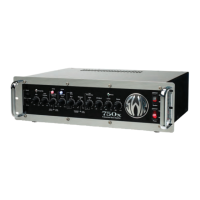8 • 750x OWNER’S MANUAL
sound, and how much of a bass boost you want when engaging the SubWave™. Some users will want a sig-
nificant boost, while others may be striving for a more consistent level (or “unity gain”). Again, let your
ears and musical taste be the judge.
Pull Turbo
Pulling the Bass Control knob to the “out” position widens the bandwidth of the bass control, and changes
the center-point frequency from 80 Hz to 40 Hz. It has the effect of more clearly enunciating frequencies
down to 30 cycles (low “B” on a five string bass). Often these notes can be felt more than heard, so you
may want to re-check the Preamp Clip LED, and listen for power amp clipping or speaker distortion as
well. Constant clipping of these frequencies can diminish the life of the speakers or cause them to fail
much sooner than expected.
Note: Setting both the Bass (with or without Pull Turbo engaged) and SubWave™ Level controls near or at
maximum boost will increase the overall amount of bass in your signal VERY SIGNIFICANTLY! We’re all in
favor of that, just so long as your speaker cabinet can handle the peak levels. Remember, adjust the con-
trols slowly, and use common sense.
Midrange Controls
Your 750x comes equipped with two different controls for setting the amount of midrange present: one for
boosting and cutting the level of midrange, and another for setting the specific midrange frequency that will
be adjusted in level. Both controls exist on one dual concentric knob. The Level control is located on the
inner portion of the knob, while the Frequency control is located on the outer portion of the knob.
Midrange Level Control
The Midrange Level control cuts or boosts the frequency set by the Midrange Frequency control.
Starting at mid-position, turning the Level control counter-clockwise cuts the desired tone. Turning the
Level control clockwise boosts the desired tone (set by the Midrange Frequency control). When the level
control is set at mid-position (“center-click”), turning the frequency control will have no effect on the
sound.
To find the midrange area you are looking for:
1. Adjust the Midrange Level control to the full boost or cut position.
2. Rotate the Midrange Frequency control until the desired area you wish to cut or boost is found.
3. Adjust the Midrange Level control to the desired amount of cut or boost.
Midrange Frequency Control
The Midrange Frequency control sets the area that is to be cut or boosted by the Midrange Level
control. If the Midrange Level control is set at mid-position, turning the Frequency knob will have
NO affect.
Some hints: If you need to “cut through” the band a little more, try boosting 200 to 400 Hz. If you like
a more transparent or “scooped” sound, try cutting at 800 Hz. The midrange controls are especially
useful in controlling fretless basses and their inherent qualities.
Treble Control
The Treble control employs a shelving-type circuit and boosts or cuts the high frequencies (and their subse-
quent octaves) +/–15dB from about 2 kHz to 14 kHz. Starting at mid-position, turning the control counter-
clockwise cuts the treble response, while turning the control clockwise boosts the treble response.
Pull Transparency
Pulling the Treble Control knob to the “out” position raises the lowest frequency affected by this control
from 2 kHz to 4 kHz. This may be useful if you’re looking to only boost the “high” highs, or “crystal”
highs, as opposed to a broader range of treble frequencies that some players feel add too much of the
more aggressive, high-midrange kind of treble to their tone. It can also help a set of dead strings make
it through one more gig.
Effects Blend Control
The Effects Blend Control “blends” the signal sent from your instrument with the signal coming from your

